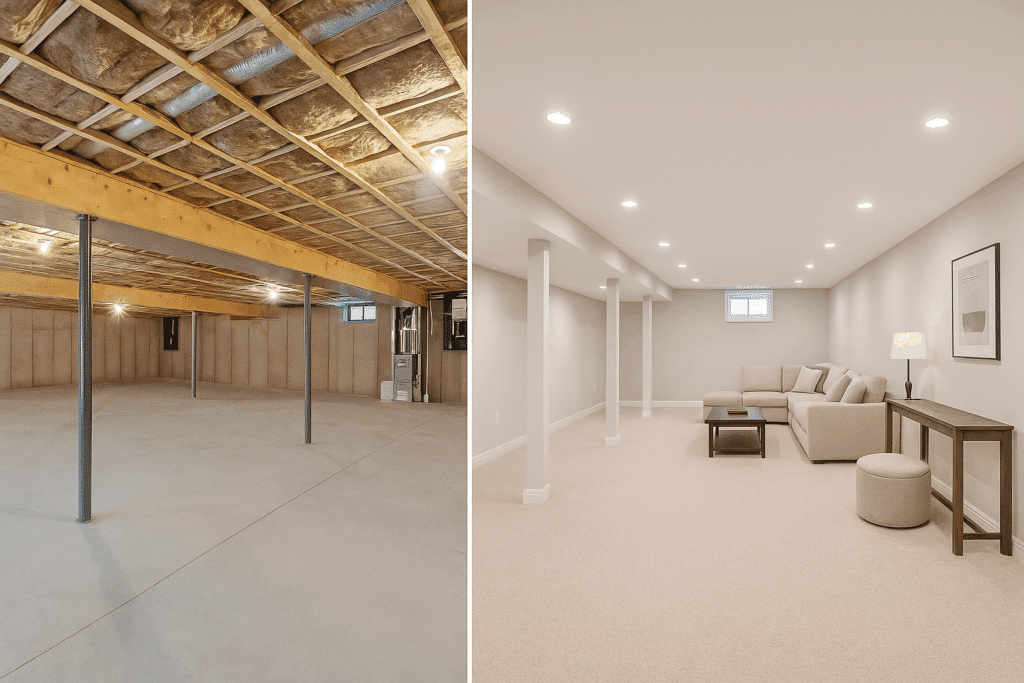Once overlooked as mere concrete-walled storage spaces, basements have evolved into some of the most versatile and valuable parts of a modern home. This untapped potential, however, presents a common and significant dilemma for homeowners: is it better to invest in finishing the space, or leave it unfinished? A finished basement can dramatically extend your living area and boost your home’s resale value, while an unfinished basement offers immediate affordability and ultimate flexibility for future projects.
The right answer isn’t universal; it depends entirely on your personal circumstances. To help you make a confident and well-informed choice, this article will explore the benefits, drawbacks, and cost implications of both options, offering clear guidance to determine which approach best suits your family’s lifestyle, long-term goals, and budget.
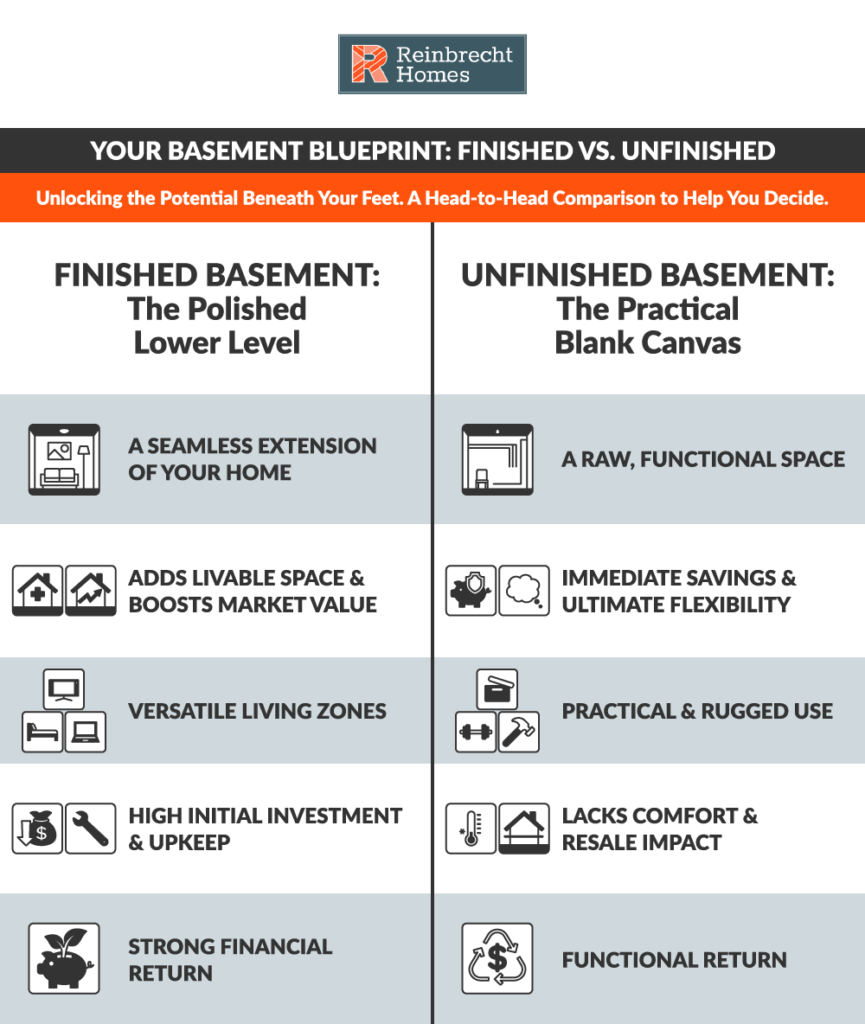
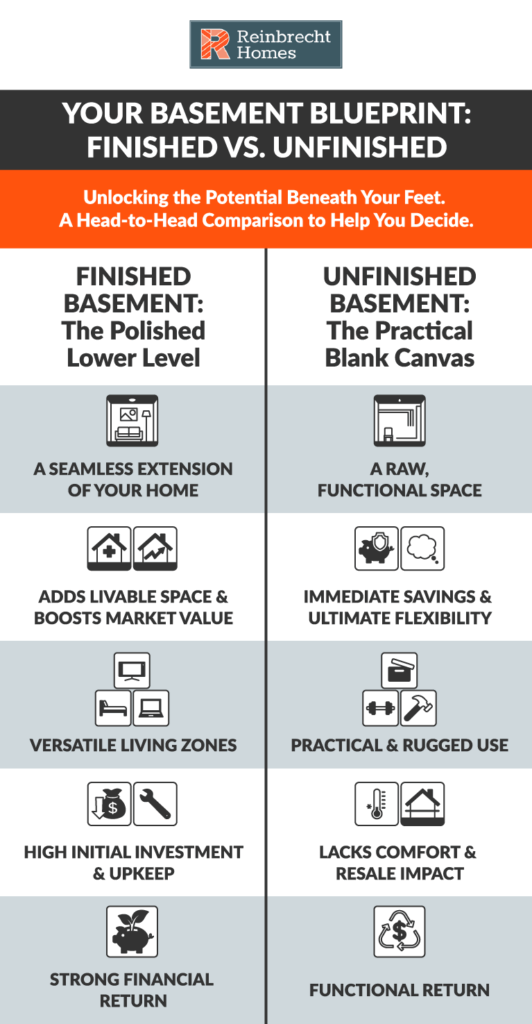
The Case for a Finished Basement
A finished basement is transformed from a utility area into a fully integrated living space that mirrors the comfort and style of your home’s main floors. This involves adding insulated walls, attractive flooring like plush carpeting or luxury vinyl plank, proper heating and cooling, customized lighting, and an overall polished aesthetic. This option is ideal for homeowners looking to maximize every square foot of their property.
Benefit: Expands Your Living Space and Boosts Home Value.
Finishing your basement is the most efficient way to increase your home’s livable square footage without the immense cost and disruption of an above-ground addition. This new space can be a game-changer for growing families or those who love to entertain. Furthermore, a well-executed basement finish is a highly sought-after feature for potential buyers, adding significant market appeal and often yielding a strong return on your investment.
Use Case: Entertainment, Guest, and Work Zones.
The possibilities are nearly endless. A finished basement is the perfect canvas for dedicated spaces like an immersive home theater, a lively game room, or a stylish personal bar. It can also serve as a comfortable, private guest suite for visitors, a quiet and productive home office away from household distractions, or even a self-contained rental unit to generate passive income.
Drawback: Higher Upfront Cost and Ongoing Maintenance.
The primary downside is the significant financial investment, which includes not just construction but also permits, design fees, and furnishings. The project also requires construction time and can be disruptive. Once complete, the space demands ongoing maintenance, including monitoring for leaks, ensuring dehumidifiers are running correctly, and caring for the new floors and fixtures.
The Case for an Unfinished Basement
An unfinished basement proudly retains its raw, utilitarian qualities with exposed concrete walls, visible support beams, and easily accessible utility systems. While it lacks polished comfort, its core strengths lie in its unmatched cost-effectiveness, rugged practicality, and its role as a space of pure potential.
Benefit: Immediate Cost Savings and Ultimate Flexibility.
By forgoing a full renovation, you avoid the major expenses of insulation, drywall, flooring, and extensive electrical work. This frees up capital for other immediate needs or investments. An unfinished basement remains a “blank canvas,” allowing you to adapt the space as your family grows or your hobbies change, without being locked into a specific layout.
Use Case: Practical Storage and Mess-Friendly Workshops.
The open, durable layout is perfect for storing bulky equipment, seasonal decorations, and outdoor furniture. There’s no need to worry about the spills, scratches, or dents that would mar a finished space, making it an ideal area for a woodworking shop, a craft station, or a home gym with heavy equipment.
Drawback: Limited Comfort and Lower Resale Impact.
The practical benefits come at the cost of comfort. Concrete floors can be cold and damp, and poor lighting can make the area feel uninviting. While it doesn’t detract from your home’s value, an unfinished basement is often seen as a missed opportunity by potential buyers and won’t provide the same resale boost as a finished one.
Cost Analysis: Finished vs. Unfinished Basements
The financial impact is a critical factor in this decision.
Finished Basement Costs
The price of finishing a basement varies dramatically. Sources like BobVila and Angi show ranges from as low as $2,800 for a basic job to over $100,000 for a high-end, complex renovation. The national average often falls between $18,000 and $35,000. This wide range reflects the difference between a simple, open-plan family room and a deluxe build-out featuring a custom bar, a full bathroom, and a legally required egress window. Factors such as insulation, drywall, flooring, electrical work, HVAC improvements, and special features like a kitchen or bathroom all influence the final cost.
Unfinished Basement Costs
An unfinished basement has minimal initial costs. Any investment is typically focused on safety and preventing future problems. This might include sealing foundation cracks to prevent water intrusion, painting the concrete walls with waterproof paint, or installing basic, safety-compliant GFCI outlets and functional lighting.
Beyond Comfort: Analyzing the Return on Investment (ROI)
While the immediate cost of a basement project is a primary concern, it’s equally important to consider the long-term financial impact, especially the Return on Investment (ROI). ROI measures how much of your initial investment you recoup when you sell your home.
The Financial Reality of a Finished Basement
While the immediate cost of a basement project is a primary concern, it’s equally important to consider the long-term financial impact, especially the Return on Investment (ROI). ROI helps you understand how a renovation might affect your home’s market value when it comes time to sell.
Features that Maximize Your Return
Not all upgrades are created equal. To get the most value from your investment, focus on features that add broad appeal and critical functionality for potential buyers:
- A Full or Half Bathroom: Adding a bathroom is one of the single most valuable additions to a basement.
- A Legal Bedroom: Including an egress window and a closet creates a legal bedroom, which significantly boosts value.
- An Open, Flexible Layout: Avoid overly specific or niche designs (like a soundproof recording studio) that may not appeal to a broad range of buyers. A flexible family room or recreation space is a safer bet.
The “Functional ROI” of an Unfinished Basement
An unfinished basement doesn’t offer a direct monetary ROI, but it provides a powerful “functional ROI.” The value comes from the money you save and the flexibility you retain. This saved capital can be used for other investments or home improvements with a higher direct return. Furthermore, offering a clean, dry, and problem-free unfinished basement can be very attractive to buyers who want a “blank canvas” to create their own dream space.
Basement Design Trends
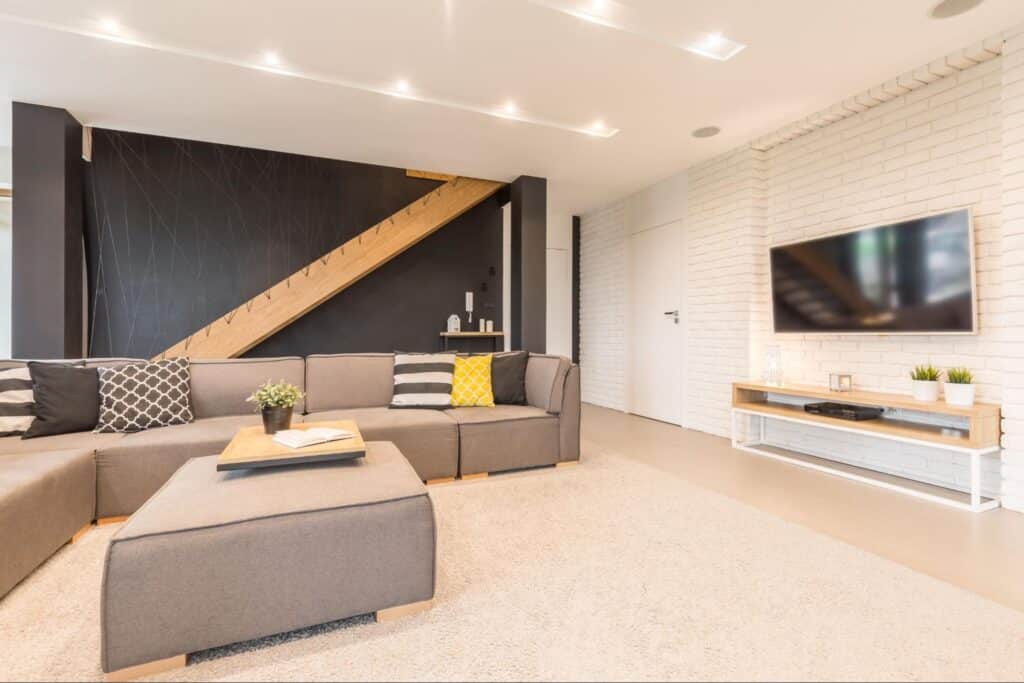
Whether you finish your basement now or later, modern design trends emphasize creating spaces that are both functional and stylish.
- Open-concept layouts remain popular, creating a seamless flow between different zones, like a TV area and a small kitchenette.
- Multifunctional design is key; think of a home office nook with a Murphy bed that allows it to double as a guest room.
- Energy-efficient solutions like LED lighting and high-R-value insulation are becoming standard.
- To combat the subterranean feel, designers often use bright neutral paint colors paired with bold accents—like a statement wall, colorful textiles, or dramatic light fixtures—to make the space feel inviting.
Decision-Making Guide: Key Factors to Consider
Ask yourself these critical questions to find your answer:
- Budget: Take a realistic look at your finances. Can you comfortably afford the upfront cost of a full renovation, or is a lower-cost, flexible option the smarter move for now?
- Purpose: What is the primary job you need your basement to do right now? If you urgently need another bedroom or family room, finishing is the priority. If your main need is storage, leaving it unfinished is perfectly logical.
- Resale Value: How soon do you plan to sell? If you’re staying for the long haul, build for your own enjoyment. If selling is on the horizon, research whether finished basements command a premium in your specific neighborhood.
- Timeline: Are you and your family prepared for a construction project that could last several weeks or months? If you need a usable space immediately, even for storage, that will influence your decision.
- Future Plans: Where do you see yourself in five years? An unfinished basement preserves your options, allowing you to design a space for the family you’ll have in the future, not just the one you have today.
Transitioning from Unfinished to Finished
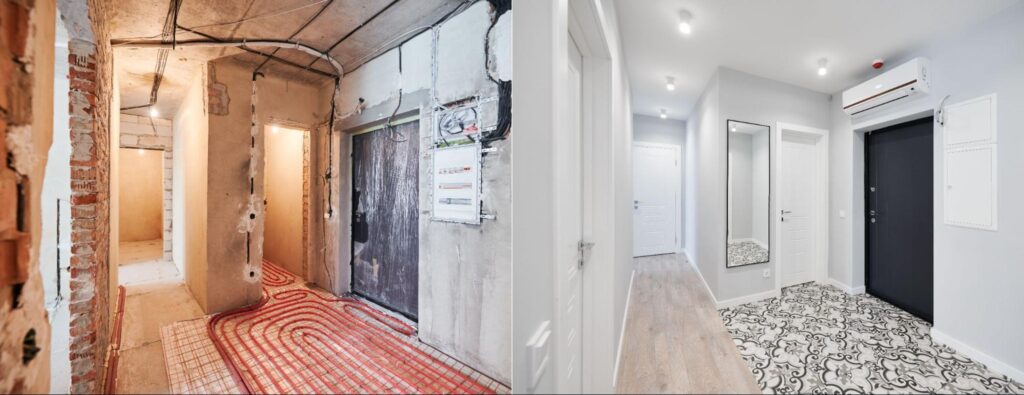
If you decide to finish your basement later, a phased and thoughtful approach is crucial for success.
- Inspect and Waterproof: This is the non-negotiable first step. Hire a professional to check for foundation cracks, moisture seepage, or radon gas. A dry basement is the only foundation for a successful renovation.
- Plan and Budget: Create a detailed floor plan. Will you need a bathroom? An egress window for a legal bedroom? Get detailed quotes from multiple contractors to build a realistic budget.
- Check Codes and Permits: Before any work begins, ensure your plans comply with all local building codes for ceiling height, electrical wiring, and fire safety.
- Hire Professionals: While you might save money on cosmetic tasks like painting, licensed electricians and plumbers are essential for safety, compliance, and peace of mind.
The Role of Professional Builders
Professional builders streamline the renovation process, ensuring code compliance and quality workmanship. Their guidance helps you avoid costly mistakes and plan effectively. For example, experienced teams—such as those promoted by Reinbrecht Homes—highlight a commitment to detailed work from waterproofing foundations to adding final decorative touches.
Making the Right Basement Decision
Deciding between a finished or unfinished basement is a significant choice that should align with your budget, lifestyle, and long-term home goals. Finished basements offer expanded living space, aesthetic appeal, and increased value, while unfinished basements provide flexibility, affordability, and a practical solution for storage and future projects.
Carefully consider your current needs and future plans. If you’re uncertain, consulting a professional homebuilder can offer clarity and expertise to guide you through the process. Contact us today to build your dream space and take the next step toward enhancing your home’s comfort and functionality.

